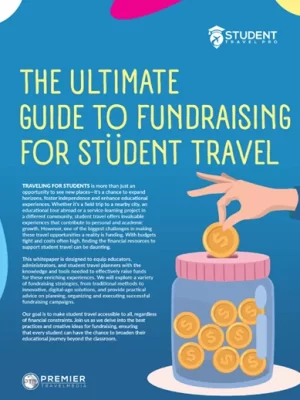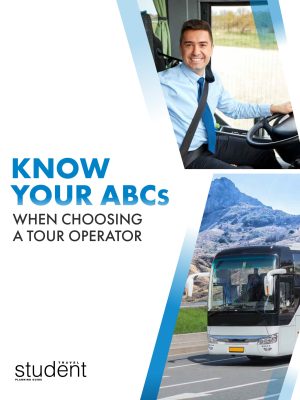Learn how to plan a successful and educational field trip with our first-timer’s guide and discover key steps and tips for a memorable outing
Field trips are the perfect opportunity for hands-on learning and exploration, transforming the mundane classroom experience into something truly memorable and educational. In fact, a study done by the US Travel Association found that regardless of gender or socioeconomic status, children who took school trips have better grades (59%), higher graduation rates from high school (95%) and college (63%), and more income (12% higher annually) than students who did not take school trips. Adventure and exploration undoubtedly lend themselves to improvement and learning, but how do you make it happen?

8 Steps to Planning a Field Trip
If you’re new to organizing field trip excursions, the logistics can seem daunting. But with the right approach, planning a successful field trip can be both manageable and enjoyable. Student Travel Pro has got you covered with these essential steps to ensure your first field trip is both fun and impactful.
1. Define the Field Trip Objectives
Before diving into the logistical details, decide what you want the field trip to achieve. Are you focusing on a specific subject like science or history, or is the goal more about team building? A field trip will inevitably achieve both team building and education simultaneously, but aligning the trip with educational objectives ensures that every aspect of the excursion supports these goals.
2. Budget Wisely
Understanding and managing your budget is key. Consider all potential costs, including transportation, admission fees, meals and any extra activities. Don’t forget to include a small buffer for unexpected expenses! It doesn’t hurt to reach out to vendors for group discounts and explore sponsorship opportunities or fundraising ideas to help cover costs. Try listing out all expenses so that you can see them all in front of you at once; transparent budgeting will help you avoid surprises and ensure a smooth experience.

3. Choose the Right Destination
Select a destination that aligns with your educational goals and is accessible to all participants. Whether it’s a science center, botanical garden or historical landmark, ensure the location offers educational value and is equipped to handle group visits. Review the facility’s amenities, such as restrooms, dining areas and emergency protocols. Visiting the location beforehand can help you get a feel for the space and plan accordingly, so it’s always a good idea if possible.

4. Plan the Logistics of a Field Trip
Detailed planning is key to a successful field trip. Here’s a checklist to guide you:
- Transportation: Decide how your group will get there—by bus, train or carpooling. Arrange bookings well in advance and ensure the vehicle is equipped for the size of your group.
- Itinerary: Create a detailed itinerary, including departure and return times, planned activities and breaks. Share this with participants and chaperones to keep everyone informed.
- Chaperones: Recruit enough chaperones to maintain a safe and manageable environment. Ensure they are briefed on their responsibilities, safety protocols and the trip’s objectives. Parent volunteers are great for this but be sure it is someone trustworthy.
- Permissions and Forms: Collect necessary permission slips and medical forms from parents or guardians. This documentation is crucial for safety, liability and compliance.
5. Prepare for the Unexpected
Flexibility is key when planning a field trip. Things don’t always go as planned, so it’s important to have a backup plan. Weather conditions, unforeseen delays or other disruptions can occur. Check the weather forecast and have alternatives for outdoor activities if needed. Keep a first-aid kit handy and have emergency contact information at your fingertips. You should ask participants to pack for the unexpected so that the burden of a change of plans does not all fall on you.
6. Communicate Clearly
Effective communication with all parties involved is essential. Inform parents and guardians about the trip details, including the schedule, costs and what their child should bring. Brief students on the trip’s educational objectives and expectations for behavior to ensure a smooth experience. Regularly check in with participants and take attendance often to make sure everyone is happy and accounted for.

7. Enhance the Experience
To maximize the educational value of the trip, make the field trip as engaging as possible by incorporating interactive elements. Engage students with pre-visit activities, such as discussions or projects related to the destination. During the trip, encourage them to ask questions and participate actively. Post-visit reflections and discussions can help reinforce the learning outcomes and ensure that the trip’s objectives are met.
8. Collect Feedback
After the trip, gather feedback from students, chaperones and parents. This can provide valuable insights into what worked well and areas for improvement. Use this feedback to refine your planning process for future field trips and to address any issues that come up.
For more field trip ideas and opportunities, keep reading from our 2025 Northeast Field Trip Guide.

Time to Plan Your Field Trip!
Planning a field trip for the first time can be a lot of fun if you tackle it the right way. Start by figuring out what you want to achieve, keep an eye on your budget, pick a great spot and be ready for any surprises that come up. With a bit of preparation, you can organize a trip that’s not only enjoyable but also adds something special to what students are learning in class. Seeing the world is just as important as learning about it, so get out there!










